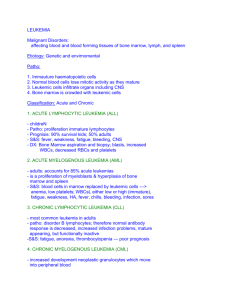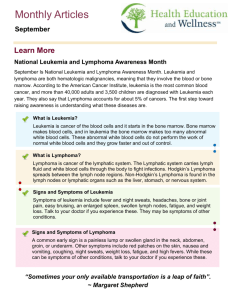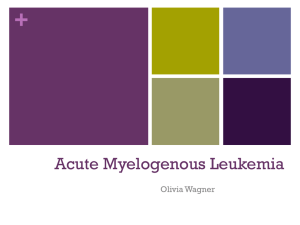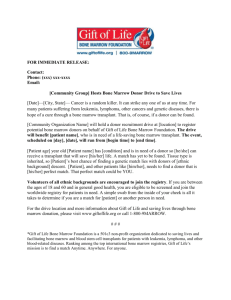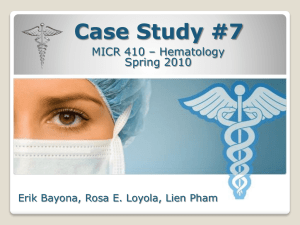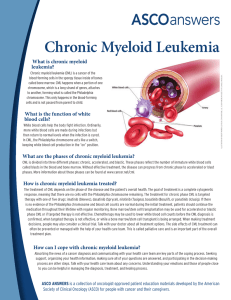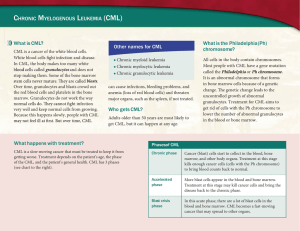Leukemias and Lymphomas
advertisement
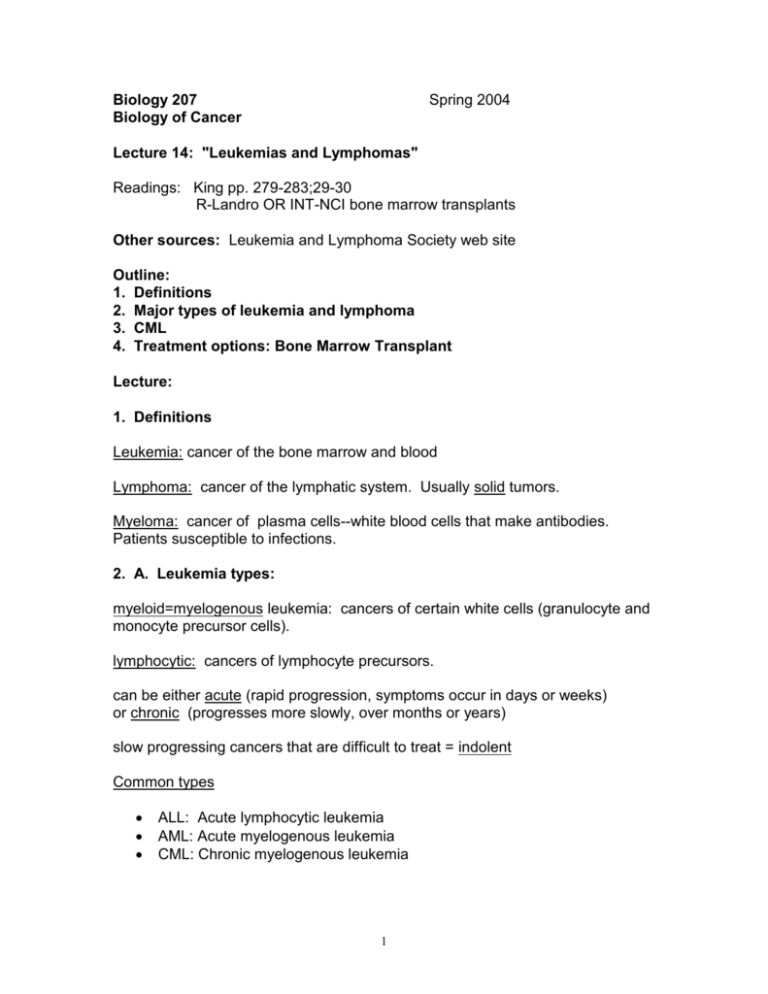
Biology 207 Biology of Cancer Spring 2004 Lecture 14: "Leukemias and Lymphomas" Readings: King pp. 279-283;29-30 R-Landro OR INT-NCI bone marrow transplants Other sources: Leukemia and Lymphoma Society web site Outline: 1. Definitions 2. Major types of leukemia and lymphoma 3. CML 4. Treatment options: Bone Marrow Transplant Lecture: 1. Definitions Leukemia: cancer of the bone marrow and blood Lymphoma: cancer of the lymphatic system. Usually solid tumors. Myeloma: cancer of plasma cells--white blood cells that make antibodies. Patients susceptible to infections. 2. A. Leukemia types: myeloid=myelogenous leukemia: cancers of certain white cells (granulocyte and monocyte precursor cells). lymphocytic: cancers of lymphocyte precursors. can be either acute (rapid progression, symptoms occur in days or weeks) or chronic (progresses more slowly, over months or years) slow progressing cancers that are difficult to treat = indolent Common types ALL: Acute lymphocytic leukemia AML: Acute myelogenous leukemia CML: Chronic myelogenous leukemia 1 B. Lymphoma types: Hodgkin’s disease: Unusual cell type observed “Reed-Sternberg cell” which causes disease. non-Hodgkins lymphomas (usually classed based on cell of origin--”Rappaport classification”) example: Burkitt’s lymphoma, caused in Africa by Epstein Barr virus C. Statistics: 109,500 people in US diagnosed with leukemia, lymphoma and myeloma this year. 11% of deaths from cancer in 2001. Leukemia is most common form of childhood cancer. Leading fatal cancers in young men under 35. D. Symptoms: Anemia Bleeding or bruising Bone and joint pain Abdominal distress Swollen lymph nodes E. Diagnosis: A number of methods including Bone marrow aspiration or biopsy Blood tests: blood count, blood chemistry 3. Case example of a type of leukemia: CML = chronic myelogenous leukemia Two phases: chronic phase, blast crisis Characteristic change in disease prior to blast crisis: Philadelphia chromosome (chromosome rearrangement that gives small chromosome 22) when oncogene is activated--fusion oncoprotein bcr-abl is produced. Treatment options: Chemotherapy, especially interferon and Gleevac Bone marrow transplant or umbilical cord blood transplant Radiation Successful treatment measured by reduction/elimination of Philadelphia chromosome in myeloid cells. 2 New treatment based on inhibitor of activated oncoprotein Gleevac is an inhibitor of the bcr-abl tyrosine kinase. Approved by FDA in May 2001 for treatment of CML, newly approved for select gastrointestinal tumors. Induced a major response in 60% of patients and complete response in 95%. Toxic side affects in 2% of patients resulted in discontinuing the drug. Effectiveness may be improved by combining with other drugs. 4. Steps in bone marrow transplant (allogeneic transplant) for CML: Bone marrow: Hollow area inside bones where blood cells reproduce and differentiate. 1. testing patient tissue antigens 2. chemotherapy, if needed to keep disease in check 3. match donor tissue antigens (twin or sibling if possible) 4. admission to transplant unit, Hickman line (6 months after diagnosis) 5. radiation and/or chemotherapy to kill patient’s bone marrow cells (including cancer cells) 6. surgical removal of bone marrow cells from donor 7. intravenous infusion of cells from donor (Steps 5-7 took about 2 weeks in hospital) 8. recovery/complications (many months) intravenous nutrition intravenous antibiotics intravenous blood or platelet transfusions as needed moniter graft rejection (graft vs. host disease) moniter for cancer cells (look for Philadelphia chromosome in certain white cells, for CML) 3
